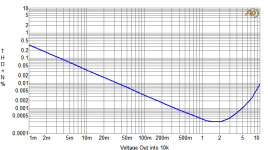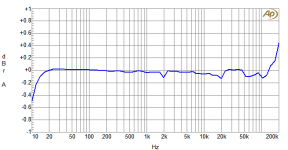Hello,
I'm trying to create a MCU controlled input selector for my tubeamp. I read many threads here about input selection and also tried myself, but all my attempts sucked quality wise.
I dont need any advice on the MCU side. This is what runs pretty well. LCD, IR remote, touch based switches and touch based rotary encoders run pretty well. This all ends in transistor based switches (dont want to burn the MCU ports, so i use transistors and switch then).
Here what i tried so far :
CMOS switches like 4066, 4013 and so on. They function pretty well, but the distortions they introduce make them unusable.
Then i tried relays. They were even worse. Especially in the lower frequencies they destroyed the beauty of audio.
After these two i tried bus switches, but same problem here.
What do you suggest for a high quality switch, that is digitally accessible? There must be an option that i don't see.
I read about relays that only need an impulse to switch and then the voltage can be turned off and they keep their state until the next switch impulse. How are they called and are they better suited for audio applications ?
Hope you can help me, i would hate it if i could not integrate the remote to switch inputs and had to walk to the amp and use some kind of mechanical switch.
Thanks
Tom
I'm trying to create a MCU controlled input selector for my tubeamp. I read many threads here about input selection and also tried myself, but all my attempts sucked quality wise.
I dont need any advice on the MCU side. This is what runs pretty well. LCD, IR remote, touch based switches and touch based rotary encoders run pretty well. This all ends in transistor based switches (dont want to burn the MCU ports, so i use transistors and switch then).
Here what i tried so far :
CMOS switches like 4066, 4013 and so on. They function pretty well, but the distortions they introduce make them unusable.
Then i tried relays. They were even worse. Especially in the lower frequencies they destroyed the beauty of audio.
After these two i tried bus switches, but same problem here.
What do you suggest for a high quality switch, that is digitally accessible? There must be an option that i don't see.
I read about relays that only need an impulse to switch and then the voltage can be turned off and they keep their state until the next switch impulse. How are they called and are they better suited for audio applications ?
Hope you can help me, i would hate it if i could not integrate the remote to switch inputs and had to walk to the amp and use some kind of mechanical switch.
Thanks
Tom
Last edited:
Another option is digitally controlled pots.
I made a USB mixer using a few of the Microchip ones MCP4231
Just don't forget to DC bias the pots to half VCC or they will distort like mad.
I made a USB mixer using a few of the Microchip ones MCP4231
Just don't forget to DC bias the pots to half VCC or they will distort like mad.
Another option is digitally controlled pots.
Or an analog pot that is digitally controlled. controls_pot_alps
Thanks for the help, but i do not get how i could select an Input with such a pot. Or do you suggest that i mute all Inputs besides one. This way it would be rather expensive, since i need six inputs.
Hope there is another option, that is a bit more affordable🙂.
Thanks
Tom
Hope there is another option, that is a bit more affordable🙂.
Thanks
Tom
Last edited:
i so not geht how i could select an Input with such a pot.
Or do you suggest that i mute all Inputs besides one.
Yes, you could mute the unused inputs and use a single remote controlled analog Alps pot.
If not, then a six digipots per channel mixer circuit is the way to go for low cost.
Last edited:
Thanks for the help, but i do not get how i could select an Input with such a pot. Or do you suggest that i mute all Inputs besides one. This way it would be rather expensive, since i need six inputs.
Hope there is another option, that is a bit more affordable🙂.
Thanks
Tom
Just set unused inputs to setting zero.
The MCP4231 are around 70p each. Each MCP4231 has 2 channels so you only need 3 IC's.
After the pots just OR the audio signals using an op-amp.
They are quite easy to control its just a serial bus.
Last edited:
Thank you very much guys. I ordered some adgs and mcps. I will give cmos and digital pots another chance. My former experiments with cmos tech shoed devestating results. I was even able to measure a connection between the controlsignal and the distortion on the cmos ics i used. But the adgs seem much higher quality, so i will give them a chance. The adg7 series seems really nice, there is a 8x2 design. This would make the switch rather easy to implement. Hope the crosstalk is not too problematic and they do not distort the signal.
I also thought about using opamps as preamps and disabling them for mute. I would mute 5 and let one run, perhaps this would do the trick. What do you think ? I dont have much experience with opamps, im more of a digital guy 🙂.
Thanks for your help so far, i began to hope, that modern cmos tech could help. I will report as soon as the ics are here and i tested them. Tomorrow i will make a pcb for the tests with digipots and the multiplexers. Hope they arrive before weekend.
On ebay signal selectors tend to use relays. Are there special audio grade relays ? My experiments with relays showed very poor low frequency performance...
I also thought about using opamps as preamps and disabling them for mute. I would mute 5 and let one run, perhaps this would do the trick. What do you think ? I dont have much experience with opamps, im more of a digital guy 🙂.
Thanks for your help so far, i began to hope, that modern cmos tech could help. I will report as soon as the ics are here and i tested them. Tomorrow i will make a pcb for the tests with digipots and the multiplexers. Hope they arrive before weekend.
On ebay signal selectors tend to use relays. Are there special audio grade relays ? My experiments with relays showed very poor low frequency performance...
Last edited:
I also thought about using opamps as preamps and disabling them for mute. I would mute 5 and let one run.
Are there special audio grade relays ?
An op amp mixer would work fine too.
Panasonic low signal level AGN relays are good.
file:///home/chronos/u-ba0979a3ce3421c5ab65a854a2128c53400eedb3/Downloads/mech_eng_gn.pdf
Take a look at the schematic of my preamp. It uses relays, it measures well, and people like the sound. Check the schematic of the input selector board.
PR-101 Stereo Preamplifier
PR-101 Stereo Preamplifier
Also the digitally controlled source selectors I used here: http://www.diyaudio.com/forums/anal...d-ldr-volume-source-selection-controller.html , made with high quality audio latching relays, are completely transparent to these ears.
The Analog Devices with the ADG prefix are excellent and quite easy to program.
Attachments
Very nice data. I think i can live with this very minimal drop at 2k and 20k.
Which adg do you think would suit best for low level input?
I consider the adg707 because of 8 dual inputs. Do you think its okay for an input selector?
Thank you very much
Tom
Which adg do you think would suit best for low level input?
I consider the adg707 because of 8 dual inputs. Do you think its okay for an input selector?
Thank you very much
Tom
The ADG707 is a low-voltage device and the THD% might be somewhat worse than the ADG1414. The lowest and flattest "on resistance" associates with higher supply voltage.
Unfortunately, the ADG1414 is TSSOP -- get yourself some adapters and solder paste -- Scott mentioned in another thread that they use a hot-plate for rework on these small parts. Would seem to be better than the toaster oven!
Unfortunately, the ADG1414 is TSSOP -- get yourself some adapters and solder paste -- Scott mentioned in another thread that they use a hot-plate for rework on these small parts. Would seem to be better than the toaster oven!
Thank you for the advice. I will take the 1414. tssop is no problem, i often have to solder smd stuff.
Thanks
Tom
Thanks
Tom
Just one more question. What do you think ? Should i switch both lines or can i use a common ground for all inputs and only switch the pluses ?
Thanks, i will post pictures and will try to make some measurements. My osci came back from repair yesterday 🙂.
Thanks to all of you, this was a very big help. I will make the PCBs over the weekend, the ICs will arrive on Mo to Tu.
Thanks to all of you, this was a very big help. I will make the PCBs over the weekend, the ICs will arrive on Mo to Tu.
I only switched the pluses.
Igor: Two nasty lookin' switches over there, but I'm not going to be the first.
You had to be around in 1974.
- Status
- Not open for further replies.
- Home
- Source & Line
- Analog Line Level
- Digitaly controlled input selector advice

